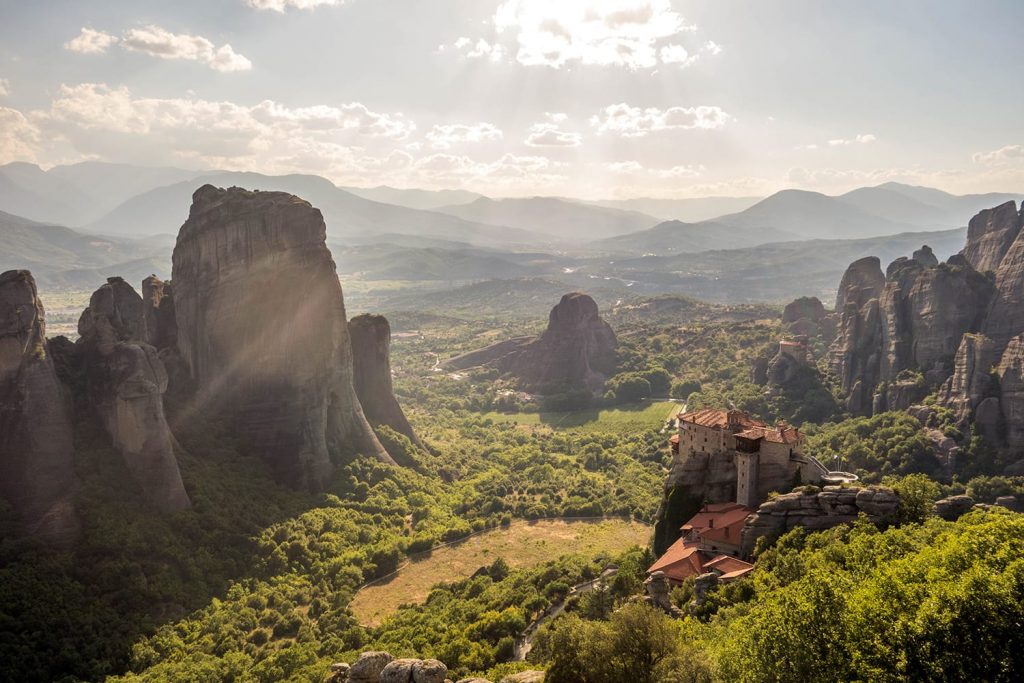
Wonders of the Mainland- Chapter 1- Meteora
Located approximately 360 Km or 4 and a half hours driving away from Athens towards the northern part of the country, this extraordinary rock formation of the Meteora region would be an unmissable tourist attraction even if they weren’t crowned by Byzantine monasteries. However, the sheer spectacle of those monasteries – somehow glued atop slender stone pinnacles by medieval masons and now collectively listed as a World Heritage site – makes this one of the most visited attractions in all Greece. This strange and beautiful landscape also offers wonderful opportunities for walkers and climbers.
Meteora is the biggest and most important group of monasteries in Greece after those in Mount Athos. We can locate the first traces of their history from 11th c. when the first hermits settled there. The rock monasteries have been characterized by UNESCO as a unique phenomenon of cultural heritage and they form one of the most important stations of cultural map of Greece.
The most important monasteries of Meteora are:
– The Holy Monastery of Great Meteoron. It is the biggest of the Meteorite monasteries. The church ‘Katholikon’, honoured to the ‘Transfiguration’ was erected in the middle of 14th c. and 1387/88 and decorated in 1483 and 1552. The old monastery is used as a museum, nowadays.
– The Holy Monastery of Varlaam is the second, after the Great Meteoro, big in size monastery. The church, honoured to the three Bishops, is in the Athonite type (cross-in-square with dome and choirs), with spacious esonarthex (lite) surrounted by dome as well. It was built in 1541/42 and decorated in 1548, while the esonarthex was decorated in 1566. The old refectory is used as a museum while North of the Church we can see the parekklesion of the Three (Bishops) built in 1627 and decorated in 1637.
– The Holy Monastery of Rousanou. It is dedicated to ‘The Transfiguration’ but honoured to Saint Barbara. The ‘Katholikon’, in the Athonite type, was founded in the middle of 16th c. and decorated in 1560. Both, the Katholikon and the reception halls are in the ground floor while the ‘archontariki’, cells and subsidiary rooms are scattered in the basement and the first floor.
– The Holy Monastery of St. Nicholas Anapausas. It is the first to meet on our way from Kastraki to Meteora. The ‘Katholikon’ dedicated to St. Nicholas, is a single – nave church with small dome, built in the beginning of 16th c. It was decorated by the Cretan painter Theophanis Strelitzas or Bathas, in 1527.
– The Holy Monastery of St. Stephen. It is one of the most attainable as we don’t have to cope with innumerable stairs to reach it. The small single-nave church of St. Stephen was built in the middle of 16th and decorated in 1545 or a little later. The ‘Katholikon’, honoured to St. Charalambos, was built in the Athonite type, in 1798. The old refectory of the convent is used as a museum nowadays.
– The Monastery of Holy Trinity is very difficult to reach. The visitor has to cross the valley and continue high up through the rock before we arrive outside the entrance. The church is in the cross-in-square type with the dome based in two columns, built in 1475-76 and decorated in 1741. The spacious barrel – vaulted esonarthex was founded in 1689 and decorated in 1692. A small skeuophylakeion was added next to the church in 1684.
Don’t miss a visit in this geological marvel, and ideally if you visit Greece, don’t just visit it and leave, but spend at least 1 full day to hike, wonder around, eat local food, and stay in one of the hotels that offer amazing views!
Author
George Tsavalos

